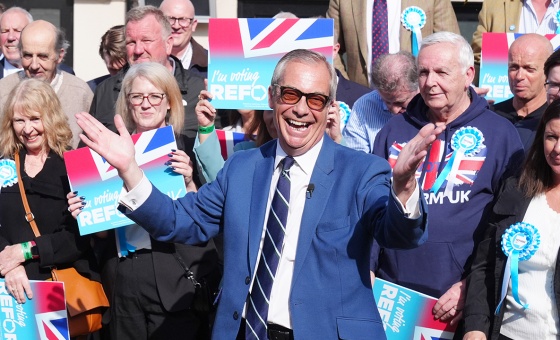This is the last article you can read this month
You can read more article this month
You can read more articles this month
Sorry your limit is up for this month
Reset on:
Please help support the Morning Star by subscribing here
The threat posed to the British steel industry when Tata Steel announced it was pulling out of Britain has led to calls for renationalisation of the industry and steel is not the only sector that growing numbers would like to see taken back into public ownership.
The post-war Labour government carried out the most comprehensive of nationalisation programmes, taking the Bank of England, the coal mines, railways, gas and electricity, iron and steel into public ownership.
Steel was later reprivatised by the Conservative government, before Harold Wilson’s Labour government renationalised it in 1967. It was re-privatised again in 1988 by Margaret Thatcher’s government, eventually becoming Corus.
The industry was just one part of the mixed economy terrain that had existed during the post-war years. This mixed economy had seen government effectively holding the ring, via the public ownership of infrastructure areas like energy, transport, steel, water, post, telecommunications and airways. Private companies formed the other part of the combination.
Just as the Attlee government had created the rubric of nationalisation and a mixed economy, so in 1979, the Thatcher government oversaw the dismantling of this structure and a return to a total market economy. Thatcher began the process that has continued right up to the present day, with Royal Mail being one of the most recent victims of the dash to privatise.
In the case of Royal Mail, the government was prepared to take over pensions and anything that could be considered a cost to potential private investors in order to prepare the way. But what Royal Mail and, most recently, the steel debacle illustrate is the total lack of any industrial strategy on the part of government.
The privatisation virus has taken such a hold that the David Cameron government now seeks to finish the job begun in 1979, selling off — to paraphrase former Conservative PM Harold Macmillan — the last few remaining bits of the family silver.
In the case of steel, the interests of the 15,000 people who stand to lose their jobs seems to count for little. It has emerged since the crisis broke that the government stood in the way of the EU efforts to block Chinese dumping of steel on the market, thereby undermining European steel industries.
The government has also refused to bring in any protective measures that would give the British industry a chance of surviving in world markets.
The steel crisis saw calls for temporary nationalisation voiced, however, the voices are growing ever louder calling for more permanent renationalisation of a number of former publicly owned industries.
Foremost among the candidates have been the railways — with Labour leader Jeremy Corbyn recently declaring that a future Labour government would look to renationalise.
The case for renationalisation of the railways is strong, with commuters paying astronomical fares for an at times unreliable service.
The RMT has argued that since privatisation, more than £11 billion has been misspent.
The union claims that fares could be substantially reduced if rail was taken back into public ownership.
There has even been a trial run of what a publicly owned railway could look like when the East Coast Mainline operated under public control between 2010 and 2015.
The service increased turnover and profits, with customer satisfaction also up.
Indeed, many believed the government was so keen to return the line to the private sector last year because it was proving just how much better a publically owned railway can operate.
Gas, electricity and water are other areas where there have been calls for public ownership to be re-established.
In all these areas, the logic of re-nationalisation is difficult to deny.
The common feature of private ownership has been cutbacks in staff, increased cost to the consumer and soaring dividend payments to shareholders.
If the money being paid out to shareholders was instead reinvested in the industry, how can the system not work better?
The better pay, terms and conditions for workers can also only be for the common good of all.
It is also not as though governments, when pushed, will not nationalise failing industry — remember the banks. The reckless behaviour of the banking industries brought the whole world financial system to the brink of collapse in 2008.
In Britain it was only the swift action of the then Labour government in taking a number of banks into public ownership that managed to save the day.
There were no qualms about cost, with £1.2 trillion of government support provided to the financial sector.
The desire to return the banks to the private sector has been paramount since then.
But think how much better things could have been if the banks taken into public ownership had been used to create a national bank which could have become a major part of creating a new industrial architecture.
A bank that would lend readily and responsibly to those seeking to build businesses and create jobs. The potential was vast but unfortunately spurned.
So the story of the banks plays an important role in rehabilitating the idea of nationalisation as a concept.
They prove that nationalisation can take place but there needs to be a long-term strategy, one that goes beyond that of a holding position before the industry or service in question can be given back to the private sector — often at a discount.
The time for renationalisation of a whole swathe of sectors including Royal Mail, energy utilities, steel and railways, has surely come.
Nationalisation can be put at the heart of a new industrial strategy that seeks to reward workers and citizens alike.
It is certainly something that Corbyn’s team must be looking at.








